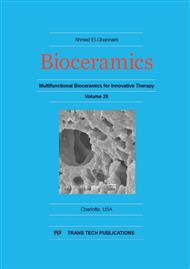p.53
p.58
p.65
p.69
p.77
p.82
p.90
p.95
p.102
The HL-60 Cells Response to Various Particle Sizes of Tetracalcium Phosphate Ceramic Delivery System
Abstract:
The specific objective of this investigation is to study the effect of tetracalcium phosphate (TeCP) delivery system fabricated from three different particle sizes (<38, 45 and 75 um) on the viability of HL-60 cell line in culture. Each TeCP reservoir was fabricated using standard protocols. The sintered microcrystal material were cold pressed at 5000 kg compression load, sterilized and loaded into wells pre-plated with 106 HL-60 cells. At the end of 24, 48, and 72 hours, the supernatants (cell suspension) from the wells were collected for cell count (a hemacytometer method) and lactate dehydrogenase (LDH) assays. The cells were evaluated for structural cellular damage by using conventional histopathological protocols (H&E stain). Results obtained from this investigation suggest the followings: (i) particle sizes are key elements in developing TeCP delivery system, (ii) the use of <38 um particle sizes would be favorable for long duration of delivering biologicals from the TeCP reservoirs due to the viability of HL-60 cells, (iii) LDH activities were directly proportional the particle sizes of the ceramic capsules compared to the control and (iv) there were less cellular structural changes in devices fabricated from <38 um particle sizes and the cells became more reactive with an increase in particle sizes.
Info:
Periodical:
Pages:
77-81
Citation:
Online since:
November 2016
Authors:
Price:
Сopyright:
© 2017 Trans Tech Publications Ltd. All Rights Reserved
Share:
Citation:


